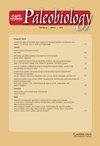佛罗里达中新世马(Equidae)的物种出现:采样、生态,还是两者兼有?
IF 2.7
2区 地球科学
Q2 BIODIVERSITY CONSERVATION
引用次数: 0
摘要
在中新世晚期和上新世早期(Hemphillian 晚期,Hh4 区间,5.7 至 4.75 千兆年),北美洲广泛分布着四种已灭绝的马(马科),其中包括 Nannippusztecus、Neohipparion eurystyle 和 Dinohippus mexicanus。其中包括 Nannippus aztecus、Neohipparion eurystyle、Astrohippus stocki 和 Dinohippus mexicanus。在佛罗里达州,还有两个马科物种,即 Pseudhipparion simpsoni 和 Cormohipparion emsliei,也通常出现在 Hh4 地点。在这里,我们对佛罗里达州四个Hh4化石地点的马进行了比较,包括三个来自骨谷矿区的化石地点和第四个来自最近发现的蒙布鲁克化石地点的化石地点。其中两个地点有全部六个预期物种,一个地点有五个物种,一个地点只有四个物种。为了解释这些差异,我们使用了研究数据库中的物种计数和稀有度模拟来明确这四个地点中这些马的相对丰度、物种丰富度和出现率。棕榈树矿(Agrico)地点有五个马科物种,但由于生态原因,似乎缺少第六个物种。这一点与蒙布鲁克不同,蒙布鲁克遗址只有六种马中的四种。结果表明,蒙布鲁克可能缺少两个马科动物物种,原因有两个:取样偏差和生物/生态原因。我们的研究结果表明,当某些马科动物物种的总体丰度较低时,取样偏差可以解释观察到的马科动物物种丰富度。然而,包括生态学在内的其他因素,以及在分辨率足够高的情况下,或许还有时间因素,也可以解释这些化石地点和其他化石地点的个别物种的分布和出现情况。从更广阔的角度来看,像这个例子这样的分析为解决古生物学中一个长期存在的难题提供了机会,即我们如何解释化石记录中没有出现的已灭绝类群?本文章由计算机程序翻译,如有差异,请以英文原文为准。
Species occurrences of Mio-Pliocene horses (Equidae) from Florida: sampling, ecology, or both?
During the late Miocene and early Pliocene (latest Hemphillian, Hh4 interval, 5.7 to 4.75 Ma) a distinctive suite of four species of extinct horses (Family Equidae) were widespread in North America. This includes Nannippus aztecus , Neohipparion eurystyle , Astrohippus stocki , and Dinohippus mexicanus . In Florida, two additional equid species, Pseudhipparion simpsoni and Cormohipparion emsliei , are also typically found at Hh4 localities. Here we compare horses from four Hh4 Florida fossil sites, including three from the Bone Valley mines and a fourth from the recently discovered Montbrook site. Two of these sites have all six expected species, one has five species, and one has only four species present. To explain these differences, we used species counts from research databases and rarefaction simulation to clarify the relative abundances, species richness, and occurrences of these horses from these four sites. The Palmetto Mine (Agrico) site, with five equid species, appears to lack the sixth species owing to ecological reasons. This is different from Montbrook, the site with only four of the six species. Results indicate that Montbrook is likely lacking two missing equid species for a couple of reasons: sampling bias and biological/ecological causes. Our results demonstrate that sampling biases can account for observed equid species richness when the overall abundance of certain equid species is low. Nevertheless, other factors, including ecology and with sufficient resolution, perhaps also time, may also explain the distribution and occurrences of individual species at these and other fossil sites. In a broader perspective, analyses such as this example provide an opportunity to address a persistent challenge in paleontology, that is, how do we explain absences of extinct taxa from the fossil record?
求助全文
通过发布文献求助,成功后即可免费获取论文全文。
去求助
来源期刊

Paleobiology
地学-古生物学
CiteScore
5.30
自引率
3.70%
发文量
38
审稿时长
>12 weeks
期刊介绍:
Paleobiology publishes original contributions of any length (but normally 10-50 manuscript pages) dealing with any aspect of biological paleontology. Emphasis is placed on biological or paleobiological processes and patterns, including macroevolution, extinction, diversification, speciation, functional morphology, bio-geography, phylogeny, paleoecology, molecular paleontology, taphonomy, natural selection and patterns of variation, abundance, and distribution in space and time, among others. Taxonomic papers are welcome if they have significant and broad applications. Papers concerning research on recent organisms and systems are appropriate if they are of particular interest to paleontologists. Papers should typically interest readers from more than one specialty. Proposals for symposium volumes should be discussed in advance with the editors.
 求助内容:
求助内容: 应助结果提醒方式:
应助结果提醒方式:


